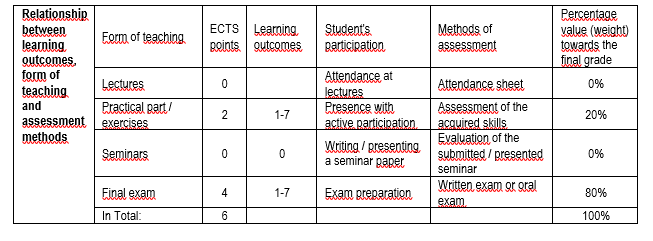Acquirement of knowledge and skills necessary for planning and conducting physiotherapeutic processes in different age groups.
Physical factors in therapy, P-35: Electrodynamic procedures that precede the physical therapy conducting, electrotherapy, electrostimulation, thermotherapy and thermo-diagnostics, ultrasound therapy, light therapy, paraffin therapy, magneto-therapy, hydrotherapy, cryotherapy and cryokinetics, laser therapy, balneology and climatology.
Therapeutic practices as part of physiotherapeutic procedures, P-35: activities for power increase, range of motion, endurance, coordination, motoric control and motoric learning, motoric development and motoric security, posture improvement and respiration, activities of aerobic endurance by the ergometry usage, mini stair masters, weights, pulleys, hydraulics, elastic bandages, robotics, mechanic and electro-mechanics means; strength increase through active movement, actively supported movement and movement with resistance; stretching; exercises on therapeutic ball; exercises in water; breathing exercises and muscle exercises that participate in breathing; breathing strategies; walk trainings, locomotion and balance; trainings of balance and coordination; ergonometric trainings.
Physical therapy in cardiology and pulmonology: Physiotherapeutic assessment in people with disorders and disease of cardiovascular and respiratory system. Psychotherapeutic process in unit of intensive care and after surgery: implantation of electro stimulator of the hearth, heart bypass and after heart implantation. Physiotherapeutic process in people with dysfunction of respiratory system because of neuromuscular diseases. Physical therapy in orthopaedics: Physiotherapeutic assessment: special test and measuring instruments for detection of disorders of muscular and bone system. Orthosis and prosthetics usage in congenital and acquired diseases, and usage of electronic devices and devices in everyday life of the patients. Basic elements of usage of PNF concepts in orthopaedics. Physical therapy in traumatology: Physiotherapeutic assessment: special tests and measuring instruments for increase of muscular and bone system. Physiotherapeutic process in people who experienced trauma of bone-joint system. Basic elements of usage of PNF concepts in traumatology. Physiotherapeutic process in people with broken muscle and broken ligament. Orthosis and prosthetics usage in amputation, prosthetics of lower and upper extremities: selection of prosthetics type, preparation for prosthetics supply and prosthetics supply.
Physical therapy in sports medicine: Physiotherapeutic assessment: special tests and measuring instruments for detection of disorders of muscular and bone system. Physiotherapeutic process in syndrome of overstrain. Basic elements of usage of PNF concepts in sports medicine. Usage of physiotherapeutic procedures in prevention of sports injuries. First aid in sports. Usage of orthosis, various types of bandages, adaptive and protective means in physiotherapeutic process and training process. Physical therapy in rheumatology: Physiotherapeutic assessment: special test and measuring instruments for detection of fracture of muscular and bone system in rheum patients and disorders.
Physiotherapeutic in neurology: Physiotherapeutic process in neurological physical therapy; Basic elements of usage of Bobath concept for adults with damaged central neurological system. Physical therapy in paediatrics: Physiotherapeutic process in states and diseases that affect the normal children’s sense-motoric development. Basic elements of usage of physiotherapeutic concepts for children: neuro-developmental treatment according to the Bobath concept, early kinesiological diagnosis and therapy according to Vojta, Halliwick concept. Teamwork in gynaecology. Teamwork and parent’s education and education of team members. Physical therapy in gynaecology with birth: Physiotherapeutic examination and treatment after gynaecological surgeries, pain in pelvis, anatomical and physiological changes of urological-genital system and post-menopause problems. Physical therapy in oncology: Physiotherapeutic process in people who suffer and are cured from tumour diseased of head and neck. Physiotherapeutic process in people after surgical treatment of breast tumour. Physiotherapeutic process of people who suffer from and are cured from tumour of digestive system and reproductive system. Physical therapy process in tumour in children’s age. Physical therapy in psychiatry: Physical therapy process in neurotic disorders, affective disorders, schizophrenia, posttraumatic syndrome, maniacal syndrome, depressive syndrome, anorexia nervosa and people with psychosomatic disorders. Physical therapy in geriatrics: Physical therapy process at elderly people.
Obavezna literatura:
Upon completion of this course, students will be able to:
- Argue the justification for the application of neuro-developmental treatment
- To determine the specific goals that are achieved through the application of neuro-developmental treatment
- Describe the components of the application of neuro-developmental treatment
- Select and manage the procedures and principles of the Bobath pediatric concept
- Select and manage Bobath concept procedures and principles for adults with central nervous system impairment
- Select and manage the procedures and principles of the Vojta concept
- Select and manage the procedures and principles of the PNF concept according to M. Knott



